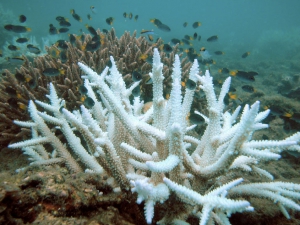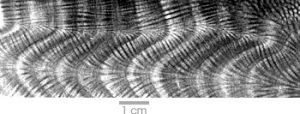Refugia under threat: Mass bleaching of coral assemblages in high‐latitude eastern Australia
By Victor Munoz, SRC MPS student
When hearing about the effects of climate change on coral reefs, most will likely think of damage from coral bleaching events (Goldberg & Wilkinson, 2004). Because bleaching has been associated with higher sea temperatures, coral reefs exposed to colder waters can sometimes be viewed as more resilient to rises in temperature (West & Salm, 2003). However, those reefs might be just as vulnerable to climate change, although in a different way to what we may think.

Figure 1. A coral colony (Photo by Daniel Hjalmarsson on Unsplash)
A recent study by researchers from the University of Queensland (Kim et al., 2019) has evaluated the performance of 8,000 coral colonies across 22 sites on the southeastern coast of Australia during the hot summer of 2016 (Figure 2). After taking several snapshots of the corals at each site, the scientists gave them a score depending on how bleached they were. They then compared the status of different coral species to environmental factors including the hottest months’ temperatures, the annual temperature fluctuation and the solar irradiance the corals were exposed to.
They found that overall, these environmental factors poorly explained the health of corals. Some species were very sensitive to changes in temperature, while others showed greater resistance to heat stress. Instead, it seems like those increased temperatures may significantly affect the diversity of corals in colder waters, with some hardy species becoming dominant over more “fragile” ones. This could have serious implications for the less resistant cold-water corals, as locations closer to the poles (where they could potentially grow) lack the environments to sustain them. The disappearance of those “fragile” corals could then lead to a reduction of the overall coral diversity, with potential repercussions on the complex functionality of the reef’s ecosystem as a hole.

Figure 2. The 22 sites included in the study, across Australia’s southeastern coast. (Source: Kim et al., 2019)
Popular discussions around climate-change tend to focus on the species that we may lose (Willis et al., 2008), but new appearances or dominance of other species in affected habitats has been just as much of a reality (Rahel & Olden, 2008). The different ways every ecosystems may be impacted by the effects of climate change still need to be studied in greater depth, but what should be understood is that no location is truly “safe” from its consequences and that changes in the environment will be witnessed from the equator all the way to the poles.
Work cited:
Goldberg, J., & Wilkinson, C. (2004). Global threats to coral reefs: coral bleaching, global climate change, disease, predator plagues and invasive species. Status of coral reefs of the world, 2004, 67-92.
Kim, S. W., Sampayo, E. M., Sommer, B., Sims, C. A., Gómez‐Cabrera, M. D. C., Dalton, S. J., … & Figueira, W. F. (2019). Refugia under threat: Mass bleaching of coral assemblages in high‐latitude eastern Australia. Global change biology. doi: 10.1111/gcb.14772
Rahel, F. J., & Olden, J. D. (2008). Assessing the effects of climate change on aquatic invasive species. Conservation biology, 22(3), 521-533.
West, J. M., & Salm, R. V. (2003). Resistance and resilience to coral bleaching: implications for coral reef conservation and management. Conservation Biology, 17(4), 956-967.
Willis, C. G., Ruhfel, B., Primack, R. B., Miller-Rushing, A. J., & Davis, C. C. (2008). Phylogenetic patterns of species loss in Thoreau’s woods are driven by climate change. Proceedings of the National Academy of Sciences, 105(44), 17029-17033.


